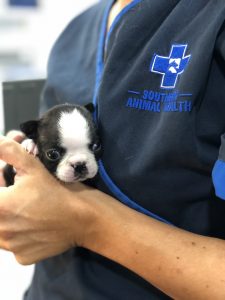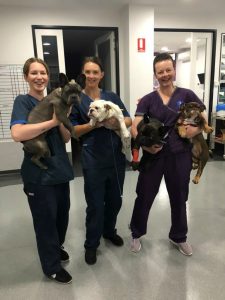
Got a Bulldog Question for One of our Experts? Click Here
Southern Animal Health incorporates Melbourne Bulldog Clinic under the guidance of experienced brachycephalic surgeon Dr Karin Davids.
We have developed this resource due to the lack of understanding of brachycephalic breeds and their specific health concerns by general veterinarians, breeders and dog owners. As there are so many differing opinions regarding these breeds, we felt it necessary to explain all the facts to dog owners so that you may have a starting point for what you need to understand if you own one of these incredible breeds, or are considering purchasing or adopting one.
We have also created a Facebook interactive group: French Bulldogs of Melbourne Healthy Living. We encourage you to join this group that allows you to swap day to day stories (these breeds give us so many!), talk to each other about your experiences, organise play dates, as well as obtain professional veterinary advice for any health questions you may have. We note there are some existing Facebook groups that are unfortunately breeder controlled (although you may not realise it), and censored to opinions that are in the self interests of the breeders controlling those sites. Hence we have established this group to be all inclusive for the benefit of you, the owner. We welcome contribution from all sources – owners, breeders, show people, and veterinarians. Our aim is to improve the lives of these breeds going forward.
Brachycephalic Obstructive Airway Syndrome (otherwise shortened to BOAS): Almost all brachycephalics suffer from this to an extent; it’s just a matter of definition. Most dogs still get through life OK, but they could get through life significantly better than just ‘OK’ if the syndrome is identified and corrected between 8-10 months for Frenchies, Pugs and Bostons, and 10-12 months for Aussie and British Bulldogs. However many other dogs really struggle through life, getting worse as the years go by and potentially developing life threatening concerns.
Below we list the very basics of what the facts are, with far more detailed explanations available of each of these facts.
The Main Points to Consider
1. The difference between ‘Need’ vs ‘Benefit’
A More Comfortable Life: “Need” Versus “Benefit” Explained.
2. Snoring is not normal
Society has come to accept snoring dogs and restricted exercise on hot days as being normal. This is incorrect. Neither is normal and it is important to educate yourself that you do not need to commit your dog to a life less comfortable than it may be by receiving incorrect advice.
3. The following anatomical concerns lead to long term inhibitory changes
Turbulent airflow from narrow nares (present in 50% of dogs) and long soft palates (present in 90% of dogs) lead to the following changes:
Everted laryngeal saccules (treatable with surgery), redundant pharyngeal mucosa and stage 2 and 3 laryngeal collapse (all not treatable with surgery and the reason dogs get worse with their breathing with age). For these reasons early intervention to prevent the non-treatable changes is most important.
4. Why consider assessment of airways, and if appropriate, corrective surgery
There are two main reasons to correct abnormal airways. Firstly, because performed early it’s quick, simple, relatively low cost (if it is done at desexing) – and non invasive, and gives the best guarantee possible that your dog doesn’t just get through life OK, but will be as comfortable as possible with their breathing for life. The second important reason is to significantly reduce the chance that your dog suddenly presents with severe breathing concerns due to secondary changes that can no longer be addressed, redundant pharyngeal mucosa and laryngeal collapse, that on occasions are life threatening. You may refer to our case studies for more examples of this.
5. When is the best time to consider corrective surgery?
8-12 months is ideal. Over two years of age long term results drop more rapidly due to irreversible redundant pharyngeal mucosa. The absolute ideal time is at desexing (if you are desexing), but you must find a quality brachycephalic specific surgeon.
6. What outcome can you expect from surgery?
Performed at 8-12 months, 90% of dogs will exhibit moderate to significant improvement, and significantly reduce the potential for progressive concerns throughout their life. After 12 months this slowly reduces in effect to two years. After two years this reduces more rapidly, but will still help prevent breathing concerns worsening. So essentially 8-12 months of age is best, ideally before two years of age, but no age is too old.
 7. If my dog is not noisy should I still have the airways assessed? Yes.
7. If my dog is not noisy should I still have the airways assessed? Yes.
50% of dogs that initially have no noise still have excessively long palates and correcting this before noise starts is far better than waiting until noise starts, as the delayed onset of noise indicates non-corrective anatomical changes will have started.
8. How to find the best surgeon
This is really simple, ask two questions:
“Are you experienced in removing everted laryngeal saccules? And are you experienced in not just shortening a palate, but thinning the palate also if it is excessively thick?”
If you receive a “Yes” answer to both, you have an excellent surgeon!
9. How is the surgery done and how invasive is it?
Performed early by an experienced surgeon it is non traumatic, relatively non invasive and recovery is very quick and easy. Done later with secondary changes recovery can become a little rough for a few days to possibly a few weeks for those being done later in life when breathing problems are really progressing. Hence our strong advice that assessment at desexing by a surgeon that answers “Yes” to the two questions above.
10. Brachycephalic extra considerations
Brachycephalic breeds also suffer (to varying degrees), the following conditions that you should at least be familiar with:
- Caudal aberrant turbinates
- Hyperplasic intranasal turbinates
- Hypoplastic trachea
- Hemi-vertebrae and
- Hip dysplasia
It is an option to screen for these concerns for owners that want a full health picture of their dog.
11. BOAS related vomiting, regurgitation, reflux and wind
This is the most misdiagnosed and misunderstood problem in brachycephalics. The basics are as follows:
- Intermittent reflux and regurgitation (as well as vomiting and excessive wind) is related to airway restrictions in approximately 80% of cases
- Early airway correction has a significant chance of reducing or eliminating these gastroenteric problems
- The remaining 20% of these problems are mostly caused by pyloric stenosis, sliding hiatal hernia or IBD (food intolerances)
- Many owners of brachycephalic breeds waste thousands of dollars doing tests that are rarely rewarding
- An excellent initial approach to gastroenteric problems is airway correction for two reasons: Firstly, all dogs lead much better lives with better airways, and secondly, almost all the above signs significantly reduce or stop all together. It’s also far cheaper than chasing the diagnostics for the 20% of other reasons
Hence the option of just correcting the airways first is something owners of these breeds should consider, given all dogs benefit from that anyway regardless of gastro-enteric signs. But it is extremely important you do appropriate airway correction and understand what that means.
Performed at desexing around 8-12 months makes it affordable, easy and a single surgery. We recommend you never have a brachycephalic breed desexed without the option of a genuine brachycephalic veterinarian doing the desexing so that abnormalities can be corrected at that same time.
12. Breeders and their advice (and how to find a good one)
Much breeder advice is incorrect so always check with an experienced brachycephalic veterinarian. A good breeder will simply admit that anatomical airway concerns are part of the breed, and that there may be extra costs involved. They will advise that you see an experienced surgeon either at desexing (if you are desexing), or no later than 12 months if not desexing, and correct any anatomical concerns if appropriate, as at that stage it will be cheap, non traumatic and give a lifelong result of the best breathing possible. Any advice to the contrary is wrong. Be very wary of breeders claiming their dogs never have airway concerns and would not benefit from corrective surgery if appropriate. Also be questioning of the veterinarians these breeders recommend. If the breeder recommended veterinarian doesn’t advise as per our recommendations, seek another opinion before desexing or making any decisions. The right information is fairly self explanatory and should make sense to you.
13. Dr Philip Moses and Frenchie’s Australia
As an extra resource to ensure you have the correct advice, please refer to one of the most respected specialists when it comes to brachycephalic breeds, as well as the wonderful French Bulldogs Australia that provides “honest information”. ![]()
14. Case Studies
Explore some significant case studies.
15. Testimonials
Many of these stories may resonate with your own experiences and help back up the correct advice.
16. Dr Karin Davids
Meet our recommended experienced brachycephalic surgeon.
17. Our unique Bulldog education seminars
Our one on one phone education seminars are something every new brachcephalic dog owner should be privy to. During these sessions we cover all the health aspects you should understand and consider.


